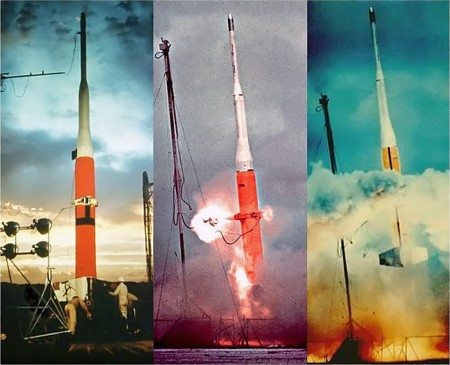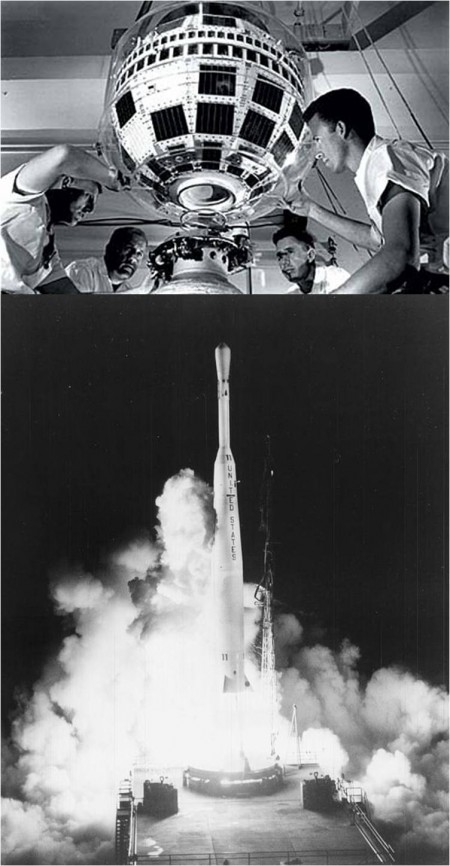
Forty-nine years ago this month, the United States abandoned a 7-year effort to develop a nuclear-armed, supersonic cruise missile. The joint USAF-AEC program was known as Project Pluto. The centerpiece of this program was the nuclear-fueled, ramjet-powered Supersonic Low-Altitude Missile (SLAM).
The 1950′s saw the development of myriad aircraft, missile and submarine concepts designed for delivery of nuclear weaponry over strategic distances. This developmental activity was driven by the escalating Cold War between the United States and the Soviet Union. In addition to weapons, the power of the atom was also considered for propulsion applications during this era.
SLAM was perhaps the most fearsome weapon ever conceived. The missile was designed to deliver as many as 26 nuclear bombs over the Soviet Union in a single mission. It would do this while flying at Mach 3 and less than 1,000 feet above ground level. SLAM’s shock wave overpressure alone (162 dB) would devastate structures and people along its flight path. And, as if that were not enough, the type’s nuclear-fueled ramjet would continuously spew radiation-contaminated exhaust all over the countryside.
The SLAM airframe was huge. It measured 88 feet in length, nearly 6 feet in diameter and weighed 61,000 pounds at launch. The vehicle would be fired from a ground-based launch site and accelerated to ramjet takeover speed by a trio of jettisionable rocket boosters. The nuclear-fueled ramjet was rated at 35,000 pounds of thrust.
To find its way to the target area(s), the Ling-Temco-Vought (LTV) SLAM would use a guidance system known today as TERCOM – Terrain Contour Matching. At a target, SLAM would eject an atomic warhead upwards from its payload bay. The resulting lofted trajectory gave SLAM time to depart the hot target area prior to weapon detonation. Following completion of its mission, the missile would then ditch itself by diving into a deep ocean graveyard.
The heart of the Project Pluto missile was the nuclear-fueled ramjet. An unshielded nuclear reactor, code named TORY, was devised, built and successfully tested. Testing was conducted at a special-purpose test site in Nevada. In its Tory II-C configuration, the SLAM ramjet produced over 500 megawatts of power in 5 minutes of continuous operation during a test conducted in May of 1964.
SLAM’s nap-of-the-earth, supersonic flight profile would subject the airframe to terrific airloads, vibrations and temperatures. The Project Pluto team successfully devised structural and thermal material solutions to handle the daunting flight environment. In addition, nuclear-hardened electronics and flight controls were successfully developed.
From a technological standpoint, Project Pluto proved to be entirely viable. However, doubts about its implementation started to arise as flight testing of the nuclear-powered missile was seriously considered. Where do you flight-test a radiation-spewing missile? What happens if you can’t turn-off the reactor? What do you do if the guidance system fails? Where do you dispose of the missile after a flight test? These and other disturbing questions began to trouble program officials.
Coupled with the above practical concerns of SLAM flight testing were growing political and mission obsolesence issues. Pentagon officials ultimately deemed Project Pluto as being highly provocative to the Soviet Union in the sense that the communist super power might feel compelled to develop their own SLAM. Further, American missilery was quickly developing to the point where ICBM-delivered warheads would do the job and at a lower per-unit cost.
So it was that on Wedneday, 01 July 1964, Project Pluto was canceled after 7 years of fruitful development. While no airframe was ever built and tested, SLAM technology was applied to a host of subsequent aerospace vehicle developments.
SLAM would truly have been “The Missile From Hades” had it matured to the point of flight. Indeed, the ethical issues concerning the missile’s use were quite sobering. And, owing to Murphy’s Law and its many corollaries, the chances for unintended catastrophe were high as well. Despite the allure of this ”technically sweet” solution to a national defense problem, the decision to cancel Project Pluto was ultimately the only correct course to follow.

Forty-four years ago this month, the United States of America landed two men on the surface of the Moon.
The Apollo 11 Lunar Module Eagle landed in Sea of Tranquility region of the Moon on Sunday, 20 July 1969 at 20:17:40 UTC. Less than seven hours later, astronauts Neil A. Armstrong and Edwin E. Aldrin, Jr. became the first human beings to walk upon Earth’s closest neighbor. Fellow crew member Michael Collins orbited high overhead in the Command Module Columbia.
As Apollo 11 commander, Neil A. Armstrong was accorded the privilege of being the first man to step foot upon the Moon. As he did so, Armstrong spoke these words: “That’s one small step for Man; one giant leap for Mankind”. He had intended to say: “That’s one small step for ’a’ man; one giant leap for Mankind”.
Armstrong and Aldrin explored their Sea of Tranquility landing site for about two and a half hours. Total lunar surface stay time was 22 hours and 37 minutes. The Apollo 11 crew left a plaque affixed to one of the legs of the Lunar Module’s descent stage which read: “Here Men From the Planet Earth First Set Foot Upon the Moon; July 1969, A.D. We Came in Peace for All Mankind”.
Following a successful lunar lift-off, Armstrong and Aldrin rejoined Collins in lunar orbit. Approximately seven hours later, the Apollo 11 crew rocketed out of lunar orbit to begin the quarter million mile journey back to Earth. Columbia splashed-down in the Pacific Ocean at 16:50:35 UTC on Thursday, 24 July 1969. Total mission time was 195 hours, 18 minutes, and 35 seconds.
With completion of the flight of Apollo 11, the United States of America fulfilled President John F. Kennedy’s 25 May 1961 call to land a man on the Moon and return him safely to the Earth before the decade of the 1960′s was out. It had taken 2,982 demanding days and much national treasure to do so.
Mission Accomplished, Mr. President.

Fifty-seven years ago this week, the triple-staged USAF/Lockheed X-17 successfully flew its first aerodynamic heating research mission. The hemispheric reentry test article achieved a peak Mach number of 12.84 during the high temperature flight experiment.
In the early 1950’s, the United States began developing its first stable of Intercontinental Ballistic Missiles (ICBM’s). Among the many technical issues facing engineers at that time, perhaps the most vexing was that of reentry vehicle survivability owing to the extreme temperatures encountered in hypersonic flight. These high temperatures resulted from the flow deceleration which occurred within the reentry vehicle bow shock wave as kinetic energy was transformed to thermal energy.
The temperatures within the shock layer of a hypersonic reentry vehicle can exceed 10,000 degrees Fahrenheit. Indeed, there is enough kinetic energy in the flow that should it all be converted to thermal energy, the reentry vehicle material would be vaporized. The pressing challenge in the 1950’s was to determine how to shape the vehicle such that the kinetic-to-thermal energy conversion process transferred most of the energy to the air rather than the vehicle.
H. Julian Allen and Alfred Eggers of the National Advisory Committee for Aeronautics (NACA) discovered that a blunted forebody would significantly reduce the magnitude of aerodynamic heating relative to that of a sharp or pointed body. However, the concept needed to be tested to confirm its validity. Wind tunnels that could provide full-scale flight Mach number, Reynolds number, and temperature similitude did not exist at the time. Thus, the only recourse was flight test.
The X-17 Program was established to provide the first hypersonic, high-altitude flight data relative to entry vehicle aerodynamic heating. The United States Air Force contracted with Lockheed for development of a vehicle capable of boosting reentry vehicle test articles to hypersonic flight conditions. The idea was to acquire aerodynamic heating data for various reentry vehicle shapes. The fast-paced program was driven by the urgency of national defense interests.
The Lockheed-developed X-17 was a three-stage vehicle. It measured 40.5 feet in length and had a maximum diameter of 31 inches. The first stage rocket motor did the heavy lifting. The Thiokol XM-20 solid rocket motor produced an average thrust of 48,000 lbs for 28 seconds. Burnout occurred at Mach 5 and 90,000 feet.
Following first stage burnout, the entire X-17 launch stack coasted to an apogee of about 500,000 feet. The vehicle went over the top at around Mach 0.8. The gravitationally-aided fall back toward the earth caused the vehicle’s velocity to build-up rapidly. Indeed, as the X-17 passed through 120,000 feet on the way downstairs, the Mach meter reading was back up to 5.
Second stage propulsion consisted of a trio of Thiokol XM-19 rocket motors which produced a combined thrust of 101,700 lbs for 1.5 seconds. These motors were ignited shortly after the empty first stage was jettisoned. The resulting high acceleration drove the vehicle to a Mach number approaching 10 as the X-17 passed through 72,000 feet. The second stage was jettisoned just after burnout.
A single XM-19 rocket motor comprised third stage propulsion. Peak acceleration was better than 90 g’s resulting in the X-17 payload reaching a burnout Mach number of about 14 at 55,000 feet. The temperature measurement period between maximum Mach number and Mach 2 was brief; on the order of 10 seconds. These temperature data were telemetered to the ground since the test article was completely destroyed at impact.
The first X-17 aerodynamic heating research mission was launched on Wednesday, 17 July 1956 from the Air Force Missile Test Center (AFMTC) near Cape, Canaveral Florida. The X-17 system worked well as the hemispheric reentry vehicle test article reached a maximum velocity of 8,184 mph or Mach 12.84. Apogee for this first X-17 research mission occurred at an altitude of 465,000 feet.
A total of twenty-five (25) aerodynamic heating research missions would ultimately be flown during the X-17 Program. The last of which occurred in March of 1957. This very successful test effort produced a wealth of first-ever heat transfer data that helped write the book on reentry vehicle design. Key findings included the effects of boundary layer transition, external shape, and high temperature material thermal response.
The X-17 Program was among the most important of the 1950’s. Indeed, both the Atlas and Titan Programs conducted initial tests of their respective reentry vehicle designs using the X-17 as a testbed. The upshot of this is that the United States was able to develop survivable reentry vehicles in a timely fashion during the height of the Cold War.

Fifty-one years ago this week, the United States successfully orbited the world’s first active-repeater communications satellite. Known as Telstar 1, the satellite successfully relayed through space the first television pictures, telephone calls, fax images and provided the first live transatlantic television transmission.
Telstar was a development of the Bell Telephone Laboratories for the American Telephone and Telegraph (AT&T) Company. The concept involved orbiting of a satellite that could receive, amplify and retransmit electromagnetic signals around the globe.
The Telstar satellite was spherical in shape, had a diameter of 34.5 inches, and weighed about 170 lbs. Its external surface was covered with solar cells for electrical power generation. Telstar 1 was equipped with a single transponder and an externally located antenna array.
On Tuesday, 10 July 1962, Telstar 1 was launched into space aboard a Thor Delta launch vehicle. Lift-off from Cape Canaveral’s LC-17B came at 08:35 UTC. The satellite was successfully placed into a highly elliptical 3,046 nm x 510 nm orbit with an inclination of 45 degrees and a period of 157.8 minutes.
Telstar 1’s non-geosynchronous orbit limited its availability for transatlantic signals to about 20 minutes during each orbital pass. The power of the satellite’s transponder was quite low. To compensate, ground station antennas had to be very large. These units measured 177 feet in length and weighed around 750,000 lbs.
Once in orbit, Telstar 1 went right to work. On Wednesday, 11 July 1962, the satellite successfully relayed its first television signals in a transmission that originated in the United States. Specifically, images of the American flag were relayed to a ground station in France. While image quality was crude by today’s standards, Old Glory still looked pretty good in this first broadcast.
Telstar 1 made its inaugural public transatlantic broadcast on Monday, 23 July 1962. This historic broadcast featured the Statue of Liberty, the Eiffel Tower, remarks by President John F. Kennedy, excerpts from a baseball game between the Philadelphia Phillies and the Chicago Cubs, images of the American flag waving in the breeze, and pictures of Yves Montand, a then-popular French singer.
Telstar 1 transmitted more than 400 telephone, telegraph, fax and television transmissions during a rather abbreviated operational career. In November 1962, Telstar 1’s onboard electronics malfunctioned due to the harsh radiation environment encountered during repeated passage through the Van Allen Radiation Belts. Residual space-borne radiation from recent U.S. and Soviet nuclear weapons testing in space also contributed to the satellite’s demise.
Telstar 1 ushered in a new era in global communications. Its revolutionary technology profoundly changed life on earth in that global connectivity became more immediate and intimate. Telstar also spawned a new industry that has evolved into today’s massive global telecommunications market. Not too bad for a little ball filled with transistors, broadcasting with a weak transponder and orbiting high in the radiation-drenched heavens.

Fifty-one years ago this month, USAF Major Robert M. White flew the North American X-15 hypersonic research aircraft to a record altitude of 314,750 feet (51.8 nautical miles). In doing so, he became the first X-15 pilot to be awarded USAF Astronaut Wings.
The North American X-15 was the first manned hypersonic aircraft. It was designed, engineered, constructed and first flown in the 1950′s. As originally conceived, the X-15 was designed to reach 4,000 mph (Mach 6) and 250,000 feet. Before its flight test career was over, the type would meet and exceed both performance goals.
North American built a trio of X-15 airframes; Ship No. 1 (S/N 56-6670), Ship No. 2 (56-6671) and Ship No. 3 (56-6672). The X-15 measured 50 feet in length, had a wing span of 22 feet and a GTOW of 33,000 lbs. Ship No. 2 would later be modified to the X-15A-2 enhanced performance configuration. The X-15A-2 had a length of 52.5 feet and a GTOW of around 56,000 lbs.
The Reaction Motors XLR-99 rocket engine powered the X-15. The small, but mighty XLR-99 generated 57,000 pounds of sea level thrust at full-throttle. It weighed only 910 pounds. The XLR-99 used anhydrous ammonia and LOX as propellants. Burn time varied between 83 seconds for the stock X-15 and about 150 seconds for the X-15A-2.
The X-15 was carried to drop conditions (typically Mach 0.8 at 42,000 feet) by a B-52 mothership. A pair of aircraft were used for this purpose; a B-52A (S/N 52-003) and a B-52B (S/N 52-008). Once dropped from the mothership, the X-15 pilot lit the XLR-99 to accelerate the aircraft. The X-15A-2 also carried a pair of drop tanks which provided propellants for a longer burn time than was possible with the stock X-15 flight.
The X-15 employed both aerodynamic and reaction flight controls. The latter were required to maintain vehicle attitude in space-equivalent flight. The X-15 pilot wore a full-pressure suit in consequence of the aircraft’s extreme altitude capability. The typical X-15 drop-to-landing flight duration was on the order of 10 minutes. All X-15 landings were performed deadstick.
On Tuesday, 17 July 1962, Bob White flew his 15th X-15 mission. The X-15 and White had already become the first aircraft-pilot duo to hit Mach 4, 5 and 6. On this particular day, White was at the controls of X-15 Ship No. 3. It was the 62nd flight research mission of the X-15 Program with a target maximum altitude of 282,000 feet.
At 09:31:10 UTC, X-15 Ship No. 3 was launched from the B-52B mothership commanded by USAF Captain Jack Allavie. White lit the XLR-99 and pulled into a steep climb. His hypersonic steed rapidly gained altitude. Burnout of the XLR-99 occurred 82 seconds after ignition; 2.0 seconds longer than planned. At this point, White was traveling at 3,832 mph or Mach 5.45. Following an uneventful climb to apogee and a expertly-flown reentry, White touched-down safely on Rogers Dry Lake at 09:41:30 UTC.
The extra impulse provided by the longer-than-planned burn of the XLR-99 rocket engine drove White’s X-15 more than 32,000 feet higher than planned. The resulting apogee of 314,750 feet established a still-standing FAI world altitude record for piloted aircraft. The occasion also marked the first time that the X-15 flew higher than 300,000 feet. For flying beyond 50 statute miles (264,000 feet), Bob White received USAF Astronaut Wings; the first X-15 pilot to be awarded such.
Bob White piloted the X-15 a total of sixteen (16) times. He was one (1) of only twelve (12) men to fly the aircraft. White left X-15 Program and Edwards AFB in 1963. He went on to serve his country in numerous capacities as a member of the Air Force including flying 70 combat missions in Viet Nam. He returned to Edwards AFB as AFFTC Commander in August of 1970.
Major General Robert M. White retired from the United States Air Force in 1981. During his period of military service, he received numerous decorations and awards including the Air Force Cross, Distinguished Service Medal, Silver Star with three oak leaf clusters, Legion of Merit, Distinguished Flying Cross with four oak leaf clusters, Bronze Star Medal, and Air Medal with 16 oak leaf clusters.
Bob White was a true American hero. He was one of those heroes who neither sought nor received much notoreity for his accomplishments. He served his country and the aviation profession well. Bob White’s final flight occurred on Wednesday, 17 March 2010. He was 85 years of age.






